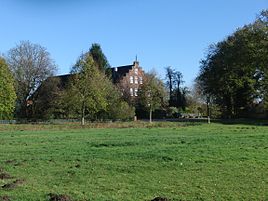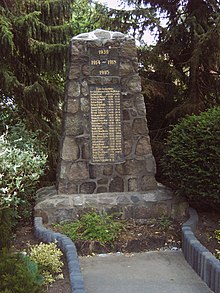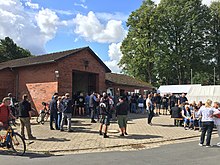Sangenstedt
|
Sangenstedt
City of Winsen (Luhe)
|
|
|---|---|
| Coordinates: 53 ° 20 ′ 45 ″ N , 10 ° 16 ′ 17 ″ E | |
| Height : | 5 m above sea level NHN |
| Residents : | 508 (Dec. 30, 2018) |
| Incorporation : | July 1, 1972 |
| Postal code : | 21423 |
| Area code : | 04171 |
|
View of the historic Porth farm in Sangenstedt
|
|
Sangenstedt is a district of Winsen (Luhe) in the Harburg district in Lower Saxony . The village is located south of Hamburg and was incorporated into the district town of Winsen (Luhe) in 1972 .
geography
Sangenstedt is located east of the core area of Winsen on the former Bundesstraße 4 , today's K 87 , which leads from Hamburg to Lüneburg . The A 39 runs south in a distance of 2 km, as does the Hanover – Hamburg line . The Ilmenau Canal runs two kilometers to the north on the border with the inland marsh. The place on the edge of the Vorgeest and the Elbmarsch is the second smallest district of Winsen with around 500 inhabitants. Because large building areas were never designated in Sangenstedt, the typical village character has been preserved to this day.
history
Sangenstedt was first mentioned in a document in 1233, which Helena von Lüneburg and her son Otto signed with the Michaeliskloster in Lüneburg. In it, Helena and Otto receive the church in Winsen an der Luhe in exchange for the St. Knut chapel on the Lüneburg Kalkberg . The certificate says: "... duas marcas denariorum dedimus de Rothorp et Sankenstede ..." , so "... two Mark Pfennigs from Rottorf and Sangenstedt", which has to be paid annually as compensation to the former mother church in Pattensen . The first courtyards were probably built as early as the 8th century, i.e. at the time of the Duchy of Saxony . Until the 19th century, Sangenstedt only consisted of three farms. Around the 13th century, the noble family, the "nobles of Sanckenstedt", settled there. The coat of arms of those at Sanckenstedt is today the coat of arms of Sangenstedt. The family, which presumably derived its name from the place name, died out in the 16th century. Nothing is known about the meaning of the three Moors Heads in the coat of arms.
In 1627 Danish troops devastated the region during the Thirty Years' War . The Winsener bailiff Berthold Kahrstedt reports in a letter that Sangenstedt was cremated. In 1631 Sangenstedt suffered again, this time from plundering Swedish troops. In the years to come, other troops kept abusing the inhabitants, so that at the end of the war the number of inhabitants in the region fell by half.
A historical trade route that was already important in the Middle Ages leads south past Sangenstedt. This was an important trade connection and travel route that connected Lüneburg with Hamburg via the comfortable Zollenspieker Elbe crossing . Mainly for military reasons, the road was built as a straight and short connection to the most important neighboring towns, which then became increasingly important as a trade and post route . Messenger courses have been used on this route since 1459. Since 1746 there has been a regular weekly postal service from Lüneburg to Hamburg. In the Kingdom of Hanover , this military road was expanded into a Chaussee and completed in 1821. Thanks to this modern connection, haulage, which transported goods to the large cities of Hamburg and Lüneburg on the new road, also gained in importance. Sangenstedt's favorable location resulted in flourishing trade. With the opening of the Hanover – Hamburg railway line in 1847, the hauliers' business collapsed and the existing trade structures almost came to a standstill. Nevertheless, this route remained popular as a travel route. Duke Friedrich von Holstein already chose this route for his trip to Berlin and Posen in 1494 . Famous personalities confirm in their records that they traveled this route. Matthias Claudius , Jens Immanuel Baggesen , Elisa von der Recke , Karl Julius Weber and Hans Christian Andersen , among others, used this route and passed Sangenstedt. Due to the ever increasing mobility that arose with the spread of the motor vehicle , the historical trade route became the later Reichsstraße or Bundesstraße 4 . During this time the first inns in Sangenstedt were built. There was a lot of attention from the population on June 16, 1906 when Kaiser Wilhelm II. Coming from Lüneburg drove past on Reichsstraße 4 in his automobile. Until 1806 Sangenstedt belonged to the Electorate of Braunschweig-Lüneburg . In 1803 Sangenstedt was occupied by Napoleon's troops and placed under French rule. Sangenstedt belonged to the Kingdom of Westphalia for a short time in 1810 , and from 1811 to 1814 to the first French Empire in Germany . After the defeat of Napoleon Bonaparte and the subsequent Congress of Vienna , Sangenstedt belonged to the Kingdom of Hanover in 1814 and then to Prussia after the war of 1866 .
Sangenstedt was involved in the first common division in the district of Winsen in 1786. After disputes, a common agricultural area was divided up for the first time. Members further it came in the 19th century in Sangenstedt to couplings of , which is a redistribution and privatization came the formerly shared agricultural land. As a result, new areas were parceled out in the districts . Through the coupling process, the farmers were freed for the first time from the dependence of their landlords and the excessive, sometimes centuries-old compulsory levies.
In the chronicle of the Sangenstedt village school, the Sangenstedt volunteer fire department was first mentioned on August 6, 1889. Organized fire protection already existed earlier.
In 1939 Sangenstedt had 177 inhabitants. The outbreak of the Second World War was not without consequences for the residents of Sangenstedt. Like many other residents of Sangenstedt, the village school teacher Hoefer received a draft order when the war broke out. The village school was closed and the children were sent to Rottorf for lessons. Shortly before the end of the Second World War , British troops marched into Sangenstedt on April 19, 1945 via Reichsstraße 4 from Rottorf . During fighting with retreating soldiers of the Wehrmacht , who fought heavy battles with the British in Rottorf the day before, several buildings in Sangenstedt caught fire.
From 1950 there were efforts by the residents of Borstels to have their own cemetery. After financial support from the community of Sangenstedt and donations from the citizens, this was built with a cemetery chapel in a wooded area between Borstel and Sangenstedt. The first burial took place here in 1957 . Due to its proximity, the Sangenstedtern make more demands on it than the responsible church cemetery in Handorf, 5 kilometers away. At the end of 2014, a funeral forest was set up on the grounds of the Borstel cemetery .
The Sangenstedter Sparklub "Smiet rin" was founded in 1962 and promoted the village community with the annual general meeting and the annual excursion. Due to the low interest rate policy , the club with a large number of members disbanded in 2019.
Until 1972 Sangenstedt was an independent municipality. The last mayor of Sangenstedt was Arthur Band. On July 1, 1972, Sangenstedt was incorporated into the district town of Winsen (Luhe).
At the end of the 1980s, construction began on the last section of the A250 , which leads past Sangenstedt to the south. In 1995 this section was opened to traffic. In 2010 the A250 was renamed and became the northern section of the A39 .
Since March 1, 2019, the "birch-oak forest near Sangenstedt" between Sangenstedt and Borstel has been under nature protection.
religion
The majority of the population is Evangelical Lutheran and belongs to the parish of St. Marien in Handorf .
politics
The mayor of Sangenstedt is Andrea Röhrs. She also represents the citizens as a member of the council of the city of Winsen (Luhe) and as a member of the district council of the Harburg district as a parliamentary group member of the CDU .
coat of arms
The Sangenstedter coat of arms was originally the coat of arms of the "Nobles zu Sanckenstedt", the Sangenstedt noble family, which died out in the 16th century. It shows a black and silver shield and silver armor with a shoulder cover on a white background and black border. The shield is adorned by two black heads dressed in green with red lips and a green wreath on their heads. The helmet has two buffalo horns pointing outwards. There in the middle there is another Moor's head with an additional ostrich feather. The Sangenstedt coat of arms is only representative and is still not recognized as an official coat of arms.
Economy and Infrastructure
Sangenstedt had its own village school until 1972 . Today the children in neighboring Borstel are enrolled in the elementary school in Borsteler Grund . The Evangelical Kindergarten "Unter dem Regenbogen" is also located in Borstel and is only about 1 kilometer away from Sangenstedt's village center. In Sangenstedt there was a village shop until 1984 and a post office until 1996 . Two restaurants and a BP petrol station were located on the B4 . The gas station was closed in 1976. Both restaurants fell victim to fire and were demolished, the latter in 1998 after the building had been in ruins for four years. The volunteer fire brigade was founded in 1889 and has also been doing youth work since 1997 . There is a children's playground and a football field in the center of the village .
The North European Natural Gas Pipeline (NEL) has been running south through the Sangenstedt area since 2013 .
traffic
Sangenstedt is on the district road 87, until 2005 the federal road 4 , which leads from Hamburg via Winsen through Sangenstedt to Lüneburg . Several bus lines lead to Lüneburg and Winsen (Luhe) and ensure regular connections to the regional transport network. The bus route 4714 travels several times a day via Sangenstedt to the Airbus plant in Finkenwerder .
Outside the bus travel times, the collective call mobile can be used in the Winsen area . It is part of local public transport .
Culture and Social
In 2003, a senior citizens' afternoon was set up for the elderly in the district, which takes place monthly in the fire station . Since 2013, the annual farmers ' calculation (Low German: Buurnreken ), a year-old citizens' meeting in spring with the participation of the mayor and mayor, has taken place.
The Sangenstedt volunteer fire department organizes the annual Easter bonfire and game evenings. Several events take place in the fire station, including church services , the village festival and the Christmas market . In November there is a lantern parade with music through the village. The amateur theater group of the MTV Borstel-Sangenstedt organizes performances once a year in neighboring Borstel.
Monuments
Sangenstedt has two monuments . In the middle of the village is the memorial for the fallen soldiers of both world wars. At the K87, the former B4, there is a historic full-mile column that was erected in 1821 during the expansion of the Heerstraße to the Chaussee . There it was destroyed in a traffic accident in 1976 and disposed of. Thanks to the courageous action of the then Sangenstedt councilor Bernhard Scheele, the traffic monument was saved and put up again on the other side of the street.
A memorial stone opposite the fire station commemorates the first mention of the volunteer fire brigade in Sangenstedt in 1889.
Sports
The MTV Borstel-Sangenstedt from 1910 has a wide range of sports on offer. In addition to various ball sports , athletics , dancing , gymnastics and gymnastics are also offered. However, the sports facilities are in neighboring Borstel. The Borstel-Sangenstedt rifle club was founded in 1950 by Borstel and Sangenstedt citizens. It also has its club facilities in Borstel. There are other sports options at MTV Rottorf, three kilometers away.
Sangenstedt borders the Habichtshorst state forest to the west, which is well suited for running. Horses are kept in the village and there is an opportunity for horse riding. On the paths through the varied nature of the Elbmarsch in the north and the forest areas in the south, the Sangenstedt area offers good opportunities for cycling tourism . The Hamburg-Schnackenburg long-distance cycle path runs 2 km north of the village center along the Ilmenau Canal and the Neetze .
nature

To the west of Sangenstedt borders the nature reserve " Birch-Oak Forest near Sangenstedt". It has a size of approx. 37 ha and consists mainly of old acid oak forests on sandy plains with the characteristic pedunculate oaks . According to the Red List of Endangered Species in Germany, this type of plant community is considered severely endangered. Because the forestry benefit of a birch-oak forest is low, many stocks in the region have been converted by pine forests or arable land, which illustrates the very high importance of this nature reserve for biotope protection and biodiversity .
literature
- City archive of the city of Winsen (Luhe).
- Günther Hagen: History of the City of Winsen an der Luhe , 3rd edition 2007, ISBN 978-3-00023-537-5 .
- Jürgen Klahn, Wilfried Mertens: Medieval documents and news about St. Marien - Winsen , Winsener Schriften - Volume 15, ISBN 978-3-9809115-6-6 .
- Peter Stein: Borstel, a village between the Marsch and Geest .
Web links
- District Sangenstedt on the website of the city of Winsen (Luhe)
- Homepage of the MTV Borstel-Sangenstedt from 1910 eV
- Homepage of the shooting club Borstel-Sangenstedt eV
- Internet presence of MTV Rottorf
Individual evidence
- ↑ a b c Sangenstedt on the website of the city of Winsen. Retrieved March 2, 2015 .
- ↑ Jürgen Klahn, Wilfried Mertens - Medieval documents and news about St. Marien - Winsen, Winsener Schriften, Volume 15, pages 17 and 18
- ^ Günther Hagen - History of the City of Winsen an der Luhe, 3rd edition 2007, page 77
- ^ Günther Hagen - History of the City of Winsen an der Luhe, 3rd edition 2007, page 77ff
- ↑ Heimatchronik des Kreis Harburg, Archive for German Heimatpflege GmbH Cologne, 1st edition 1977, p. 142
- ↑ Heimatchronik des Kreis Harburg, Archive for German Home Care GmbH Cologne, 1st edition 1977, p. 138
- ^ Günther Hagen - History of the city of Winsen an der Luhe, 3rd edition 2007, page 119
- ^ Lower Saxony Book 2008 Winsen (Luhe), page 132
- ^ Walter Gröll - On old Heidewegen - The discovery of the landscape at the time of the stagecoach, Christians Verlag Hamburg 1979, p. 142
- ^ Walter Gröll - Kurhannoversche Landesaufnahme des 18. Jahrhundert, explanations for sheet 67, new edition 1993, p. 8
- ^ Günther Hagen - Winsen in old views, Figure 16, 5th edition 1988, European Library - Zaltbommel / Netherlands
- ^ Günther Hagen - History of the City of Winsen an der Luhe, 3rd edition 2007, page 124ff
- ^ Günther Hagen - History of the city of Winsen an der Luhe, 3rd edition 2007, page 103ff
- ↑ Peter Stein - Borstel a village between Marsch and Geest, page 69ff
- ↑ The fire brigades of the city of Winsen and its districts on the homepage of the fire brigade Winsen (Luhe)
- ^ Michael Rademacher: German administrative history from the unification of the empire in 1871 to the reunification in 1990. harburg.html. (Online material for the dissertation, Osnabrück 2006).
- ^ Chronicle of the elementary school Sangenstedt, handwritten notes of the teacher M. Hoefer from 1935-1949 - City archive Winsen (Luhe)
- ↑ Herbert Rode How the Second World War ended in the Winsen area , page of the Winsener Anzeiger für Regionalgeschichte, May 20, 2009.
- ^ Sangenstedt register of residents from 1914-1959, attachment, student essays "The English are coming", Winsen (Luhe) city archive.
- ↑ Peter Stein - Borstel a village between Marsch and Geest, page 111
- ^ Federal Statistical Office (ed.): Historical municipality directory for the Federal Republic of Germany. Name, border and key number changes in municipalities, counties and administrative districts from May 27, 1970 to December 31, 1982 . W. Kohlhammer GmbH, Stuttgart and Mainz 1983, ISBN 3-17-003263-1 , p. 228 .
- ^ Winsen (Luhe) - City Council meeting overview
- ^ Harburg district - local politician of the district council
- ↑ The mobile call collection (ASM) on the homepage of the city of Winsen (Luhe)
- ^ Schützenkameradschaft Borstel-Sangenstedt eV: Home





